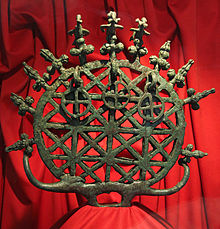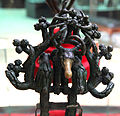Alaca Höyük's bronze standards
As a bronze statue kinds of Alaca Höyük a number of bronze objects is known that in the so-called princely graves in Alaca Höyük were found as grave goods. They are widely considered to be cult items and likely car accessories.
Find
In the years 1935–1939, the Turkish archaeologists Hâmit Zübeyir Koşay and Remzi Oğuz Arık explored the Alaca Höyük site in today's Alaca district in the Turkish province of Çorum . Among other things, they dug 14 graves from the Early Bronze Age , for which the names princely graves or royal graves have become common. In addition to the burials themselves, individually or in pairs, numerous grave goods were found, including over forty of the standards described here.
Appearance
The archaeologist Winfried Orthmann divides the artefacts into two main groups, on the one hand pure animal figures and on the other disc or ring-shaped objects with or without additional animal representations. He subdivides the second group again according to the shape and content of the discs or rings and according to the creatures shown.
The animal figures show either a deer or a bull. The feet each stand on four supports that converge to form a thorn, which was presumably used to attach it to a perishable material, probably wood. The deer have impressive antlers, the bulls have long, curved horns. The strongly stylized bodies are partly decorated with silver inlays, some of the antlers and muzzle are covered with silver or gold sheet.
The disc-shaped or ring-shaped standards are round, semicircular or diamond-shaped. Some are filled with a lattice, the edges decorated with approaches in the form of birds or flowers or a halo, occasionally movable pendants appear. Several animal figures can also be seen that are very similar to the individual animals. Here, too, mainly deer and bulls appear, but in contrast to the individual they are sometimes also grouped. For example, a deer is flanked by two bulls, while another has two lions or panthers to the right and left of the deer, looking in the opposite direction. Another example shows an animal that is interpreted as a deer or wild ass. At the lower end, the disks or rings have a pair of outwardly protruding, upwardly curved horns. They end at the bottom in a crossbar with two pegs, which were probably also used for fastening.
interpretation
Statements about the meaning and function of the artifacts are only possible to a very limited extent. The excavators Koşay and Arık assumed a clear cultic meaning and therefore initially rejected further interpretations. Because of the partly radiant ornamentation, they were often referred to as sun disks , and the surrounding rings also symbolized the vault of heaven. Kurt Bittel , among others, shares this possible interpretation . The most common theory of function was proposed by Seton Lloyd and James Mellaart and expanded by Orthmann. It says that they are parts of wagons that were given to the buried in the grave. The pieces were placed on the drawbar, perhaps at the connection point to the yoke. The designation as standards comes from this assumption . Such chariot burials are known from Ur and Kiš in Mesopotamia , but also from the Bronze Age Kurgan of Lčašen and Lalajan in Armenia . Corresponding rein rings were found there, which Orthmann compares with the standards of Alaca Höyük. As a further clue, he sees the skulls and foot bones of cattle found in pairs in the graves, which were arranged in a formation similar to a train team. It remains to be seen whether the ring- and disk-shaped standards here, as in Armenia and Mesopotamia, were also used to carry the reins. Also unanswered is the question of why no remains of the wagons were found in the graves, even though rich remains of the wooden cover of the graves were preserved.
Similar finds from Horoztepe are interpreted by the local excavator, the Turkish archaeologist Tahsin Özgüç, as a sistrum because of the moving parts .
Dating
The archaeologist Kurt Bittel shows that after stylistic comparisons of the ceramics that came to light in the princely graves, a classification in any case before the time of the Assyrian trading colonies in Asia Minor, i.e. earlier than 1900 BC. Chr., Is to be assumed. On the basis of parallels between the metal objects and those from the Troy II layer , he concludes that the grave goods were found after 2100 BC. Are to be dated. Since the different levels of burials as well as stylistic developments in the grave goods show that the cemetery was in use for a long time, possibly over two centuries, he takes the period from the 22nd to the 20th century BC. BC and with it the time of the Hittite culture, the forerunner of the Hittite Empire .
reception
The bronze standards from Alaca Höyük are used today under the name of the sun disk , often incorrectly Hittite sun disk , by various institutions in a stylized form as a logo, for example by the University of Ankara , the city and the province of Çorum. One of the standards with a deer and two bull figures and bull horns on the sides was placed on the central Sıhhiye Square in Ankara , magnified many times over .
The standards are now exhibited in the Museum of Anatolian Civilizations in Ankara and partly in the local museum of Alaca Höyük. In the Archaeological Museum Çorum replicas can be seen the tombs and the standards.
literature
- Winfried Orthmann : On the standards from Alaca Höyük In: Istanbuler Mitteilungen 17, 1967, pp. 34–54.
- Kurt Bittel : The Hittites - The Art of Anatolia from the end of the 3rd to the beginning of the 2nd millennium before Christ. CH Beck Munich 1976, ISBN 3 406 03024 6 , pp. 30-48.
- Jutta Börker-Klähn, Ute Krafzik: On the meaning of the essays from Alaca Höyük In: Die Welt des Orients Vol. 17, 1986, pp. 47-60.





